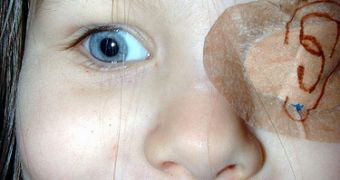Acupuncture can help some older children with lazy eye, for whom visual correction alone does not work, concluded a team of Chinese researchers.
Amblyopia, or lazy eye, is the loss of one eye's ability to see details, and it is the most common cause of vision problems in children, and also believed to affect between 0.3 and 5 percent of people worldwide.
Occlusion therapy, or patching one eye, is a quite efficient method in some older kids, but acupuncture could easily replace it, since the researchers proved that it is far more effective.
In children aged 3 to 7 years, glasses or contact lenses are successful but in the 7 to 12 age range, there are only 30 percent of positive results of visual correction alone.
Occlusion therapy helps rise the figures to two thirds but there is another way of having far better results, note Jianhao Zhao, MD, of Joint Shantou International Eye Center of Shantou University and Chinese University of Hong Kong, Shantou, China, and colleagues.
They compared the results of acupuncture – also used to treat dry eye and myopia, to those of patching in a randomized controlled trial on 88 children.
Forty three kids were randomly assigned to the acupuncture group and underwent 5 treatments a week in 5 acupoints – needle insertion sites.
The 45 remaining children had their healthy eye patched for two hours a day, and received instructions to do so at home, for at least one hour of reading or typing.
Fifteen weeks later, the visual acuity improved by 1.8 lines in the patching group, and by 2.3 lines in the acupuncture group.
An improvement of two or more lines occurred in 28 (66.7%) of those in the patching group and 31 (75.6%) of those in the acupuncture group.
Finally, lazy eye was considered treated in 16.7% of patched eyes and 41.5% of eyes in the acupuncture group.
The children had no problems with either of the treatments, and manifested no side effects.
The authors say that “although the treatment effect of acupuncture appears promising, the mechanism underlying its success as a treatment for amblyopia remains unclear.”
“The findings from this report indicate that the treatment effect of acupuncture for amblyopia is equivalent to the treatment effect of patching for amblyopia.
“However, only patients with anisometropic amblyopia were involved in our study and the follow-up period was relatively short," the authors conclude.
“Moreover, acupuncture itself is a very complicated system of therapy.
“Differences exist among acupuncturists, and there are divergent manipulation modes, stimulation parameters, treatment styles and subjective sensations evoked by acupuncture stimulation.
“Because of the good results obtained in our study, the acupoints that we used could be considered for use in clinical practice.”
Targeting vision-related acupoints can affect the activity of the visual cortex, increase blood flow to the eye and surrounding structures and stimulate the generation of compounds that support the growth of retinal nerves.
Nearly 30 to 50 percent of amblyopia cases are caused by anisometropia – differences in the degree of nearsightedness or farsightedness between the two eyes.
The report is published in the December issue of Archives of Ophthalmology, one of the JAMA/Archives journals.

 14 DAY TRIAL //
14 DAY TRIAL //